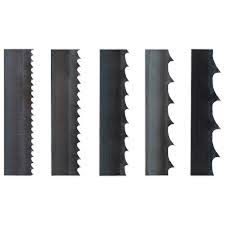Alright bandsaw folks, gather around and let’s spread some knowledge about selecting the right bandsaw blades for your projects. A happy saw starts with a blade that fits the job.
First things first, know the length you need to match your machine – usually printed right on it. Next think about width – wider is stronger and able to withstand more push power. Use the max your saw allows if possible.
And if you’re a woodturner slicing up blanks, pay attention to those minimum radii listings – you want to match your blade width to the tightest curves you’ll cut. Also, don’t forget that a blade bent to curves won’t cut straight anymore. So keep dedicated curve blades separate from straight cutting ones.
Here’s a table of blade width and minimum radius of curve:
Blade Width Minimum Radius
13mm 63mm
10mm 27mm
6mm 19mm
5mm 13mm
3mm 10mm
When it comes to tooth pattern, a skip is your go-to for ripping lumber with the grain. But for cross cuts or curves, a standard or triple chip grind will give a cleaner result.
And tooth count matters based on your materials too. Three or four TPI with a skip is ideal for deep lumber cuts. Six TPI is a solid all-around blade that handles crosscuts up to 4 inches nicely. If you’re slicing plywood or plastics though, you’ll want a finer 10TPI or more. And if doing metal, slow those RPMs way down for the best finish, especially with steel.
Tooth Pattern & Pitch Best Use
3 TPI (skip) Deep rip cuts
4 TPI (skip) General purpose use
6 TPI (skip) General purpose – cross cuts up to 150mm and rips up to 50mm
10 TPI (regular) Plywood, MDF, plastic, and non-ferrous metal. Maximum depth of 50mm
14, 24, 32 TPI (regular) Clean cuts for plastic, MDF, and plywood. Maximum depth of 25mm
So in summary, choosing the right blade length, width, and tooth options based on your materials is key. An optimised bandsaw cuts like a dream through any job!
